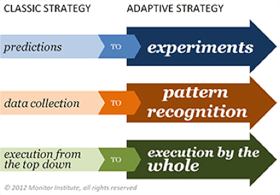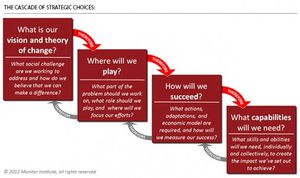Adaptive Strategy
Adaptive Strategy is a strategy that breaks free of static plans and is an ongoing learning process of a self-correcting series of intentional experiments.
Adaptive Strategy Vs. Classic Strategy[1]
In an article in the Stanford Social Innovation Review on adaptive strategy, Dana O’Donovan and Noah Rimland Flower show how adaptive strategies differ from classical strategies in the image below:

source: IntelligentHQ
They elaborate:
"Creating strategies that are truly adaptive requires that we give up on many long-held assumptions. As the complexity of our physical and social systems make the world more unpredictable, we have to abandon our focus on predictions and shift into rapid prototyping and experimentation so that we learn quickly about what actually works."
To provide structure to this fluid approach, they focus on answering a series of four interrelated questions about the organization’s strategic direction: what vision you want to pursue, how you will make a difference, how you will succeed, and what capabilities it will take to get there.

source: ssir.org
Adaptive Strategy - Why it Matters[2]
Here’s why adaptive strategy design matters and how to get it started:
- About that whole “auto” thing: An adaptive strategy ensures automatic adaptation, but that’s not going to happen, well, automatically. It is your job to create a system that’s intuitive, easy to change and upgrade, and designed to automatically respond correctly after upgrades or maintenance. “Auto” is the ultimate goal, but it’ll always take some leg work and elbow grease to get you there.
- Adaptation is the grease of business savvy: Mobile readiness falls under the umbrella of “responsive design”. The ability to adapt and respond appropriately in any context is crucial. Responsive design is centered on websites. Just because a website looks great on your laptop or tablet doesn’t mean it looks the same on every other browser or platform. What about customers using the latest iPhone or those on a really old device? Responsive design is the ability to “adapt” to every possibility (and it requires constant testing).
- The customer - and context - is always right: Why do you need to adapt and not your clients or customers? Because they can go many other places, or even just one other place, and get the kind of service they deserve. As a business owner, it’s your job to adapt to the needs of those you serve. If you don’t, you’re going to be seen as outdated, unprofessional, and uncaring about your users. Ideally, you’re also adapting to the needs of your employees and giving them the tools they need to do their best work.
- Adaptation in your strategy plan: Adaptation should be an integral part of any marketing campaign or business plan. Change is inevitable, and some industries evolve at lightning speed. To stay competitive and offer the best solutions, your business needs to do what it takes to stay on the cutting edge. Consider each of your projects and your business as a fluid, ever-changing being. That will get you on the right track.
Styles of Adaptive Strategy[3]
There are many styles of adaptive strategy that can help companies achieve business sustainability during a turbulent environment. A company’s optimal choices are mainly a function of the environment ― especially the rate at which it is changing, the predictability of change, and the degree of change required. There are four broad styles of adaptive strategy.
- The Sprinter: In environments with only a moderate degree of both turbulence and required change, companies can focus on rapidly optimizing and exploiting existing business models to track an increasingly volatile environment. The fashion retailer Zara, for example, focuses on building a fast feedback cycle between sales data from its stores and the design and manufacture of new products. This model allows the company to stay at the forefront of fashion trends without having to make big bets on where the trends are headed.
- The Experimenter: In environments where turbulence is high but the degree of change required is low, companies whose business models are fundamentally sound must nevertheless modify their product mix or other low-level aspects of their business through a process of iterative experimentation. McDonald’s, for example, uses a structured process to design, test, and introduce menu items while keeping its overarching business model unchanged. This enables it to evolve along with customer preferences and still preserve the well-honed efficiency of the kitchen model at the core of its operations.
- The Migrator: In environments with moderate turbulence and a high degree of required change, companies must deliberately migrate their obsolescent business models or domains toward more attractive ones using a targeted and deliberate process. Virgin, for instance, systematically manages a diverse portfolio of challenger businesses by rapidly scaling up potential winners and cleanly divesting or shutting down losers.
- The Voyager: In environments with a high degree of both turbulence and required change, companies need to deploy an exploratory approach to the business model or system. This can involve “live” tests with a mixed portfolio of competing business models and strategies, some of which may even be mutually contradictory. Netflix, which has reinvented fundamental aspects of its business strategy and model several times in the extremely turbulent movie-rental business, is a good example of a voyager. It removed late fees (at one time a mainstay of industry profits) and is exploring video streaming on a variety of platforms, potentially cannibalizing its DVD-by-mail business in order to stay ahead of the competition. Netflix has succeeded in dominating and reshaping a chaotic industry in which less adaptive competitors have fared poorly.
References
- ↑ Adaptive Strategy Vs. Classic Strategy IntelligentHQ
- ↑ Adaptive Strategy - Why it Matters Ring Central
- ↑ What are the Different Styles of Adaptive Strategy? Korea Times
Further Reading
- Adaptive Strategy Is a Cop-Out HBR
- Adaptive strategy making: The effects of emergent and intended strategy modes EMR
- Adapting adaptation: Expanding adaptive strategy theory to account for the East Asian business context RandyFowler, HannaGajewska-De Mattos, MalcolmChapman
